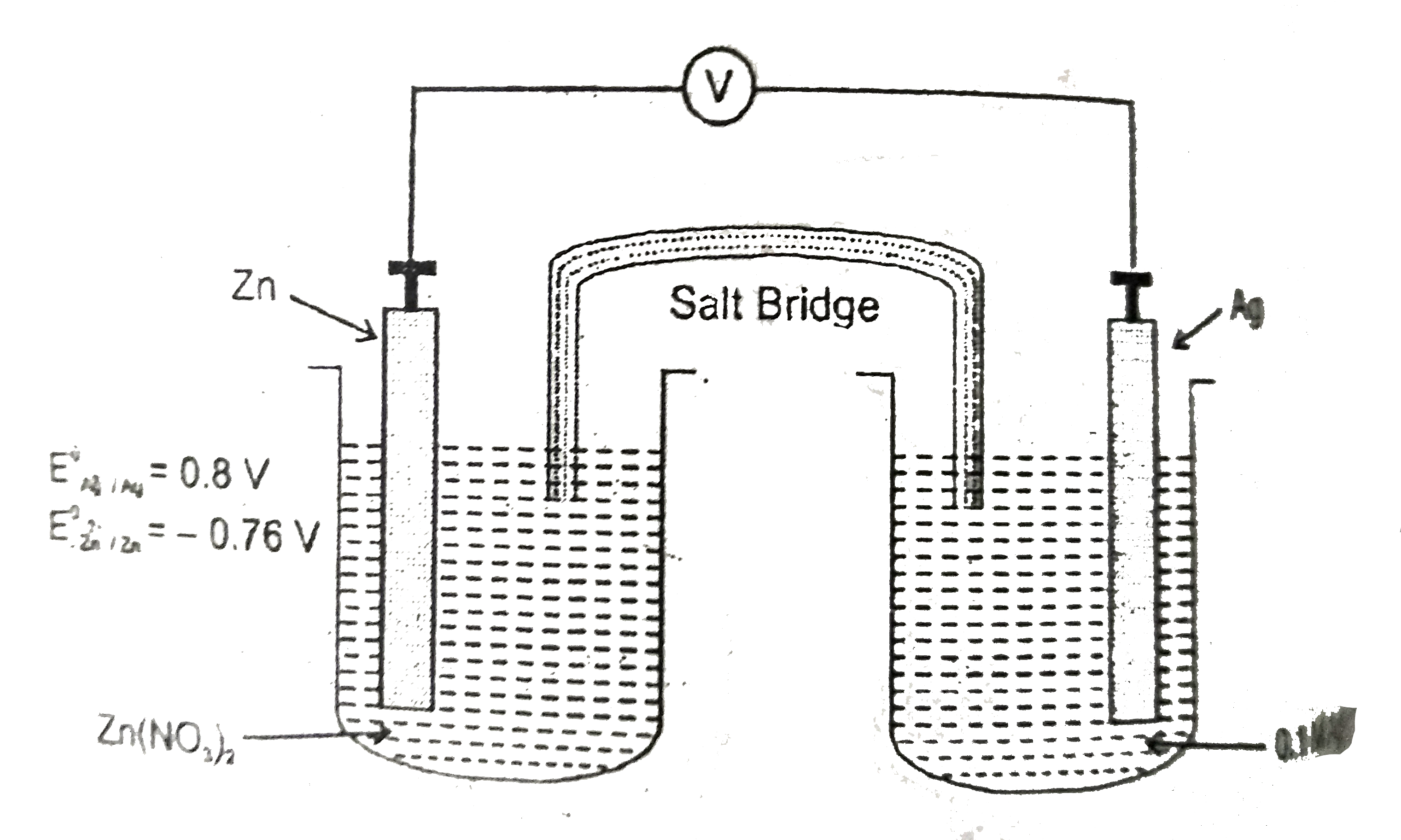Complete Solutions to HOTS of chapter ELECTROCHEMISTRY of Class 12 book with complete answers and questions
| Class 12 | CHEMISTRY |
| Chapter | ELECTROCHEMISTRY |
| DINESH COMPANION CHEMISTRY | HOTS |
| Number Of Questions | 17 |
| Academic Year | 2023-24 |
The curves obtained when molar conductivity `lambda_(m)` (along Y-axis) is plotted against the square root of concentration `C^(1//2)` (along X-axis) for two electrolytes 'A' and 'B' are shown.

(a) What can you say about the nature of the two electrolytes ?
(b) How do you account for the increase in molar conductivity `Lambda_(m)` for the electrolytes A and B on dilution ?
View SolutionThe figure shows two electrolytic cells connected in series
(a) How much electricity is required for the reduction of 1 mole of `Ag^(+)` ions to Ag ?
(b) If three Faradays of electricity are passed through these cells, what is the ratio of the cations (`Ag^(+)` and `Cu^(2+)`) deposited at the cathodes ?

View SolutionIn the dry cell
(a) Which substance acts as anode and which as cathode ?
(b) Which electrolyte is used in the cell ?
(c ) What is the cell potential of the cell ?
(d) Why does the cell voltage not change during operation ?

View SolutionTwo platinum electrides are dipped in an aqueous solution of copper sulphate blue in colour. A current is passed through it.
(a) What will happen on the two electrodes ?
(b) What will happen to the colour of the solution ?
(c ) Predict the nature of the solution left in the electrolytic cell.

View SolutionFor the redox reaction :
`Zn(s)+Cu^(2+)(aq) hArr Zn^(2+)(aq)+Cu(s)`
Reaction quotient (Q)`=([Zn^(2+)(aq)])/([Cu^(2+)(aq)])=0.01`. What will be the value of `E_(cell)` ?
Given that OA=1.10 V.

View Solution
Consider the following electrochemical cell.
(a). Write a balanced net ionic equation for the spontaneous reaction that take place in the cell.
(b). Calculate the standard cell potential `E^(0)` for the cell reaction.
(c). If the cell emf is `1.6V` what is the concentration of `Zn^(2+)`?
(d). How will the cell potential be affected if Kl is added to `Ag^(+)` half-cell?
View SolutionMagnesium metal is produced commercially by the isolation of `MgCl_(2)` from sea water followed by electrolysis of molten salt
`MgCl_(2) to Mg+Cl_(2)`
(a) What mass of Mg can be produced if a current of 430 amperes is passed for 1.0 hour ?
(b) If a current of 500 amperes is used, how many hours will be required to convert all the 1000 kg of `MgCl_(2)` into Mg metal ?
View Solution(a) In a cell reaction, equilibrium constant L is less than one. Is `E^(@)` for the cell positive or negative ?
(b) What will be the value of K if `E_(cell)^(@)=0` ?
View SolutionA silver oxide-zinc cell maintains a fairly constant voltage during discharge (1.50V). The button form of the cell is used in hearing aids. The half-reactions involved are :
`Zn(s)+2OH^(-)(aq) to Zn(OH)_(2)(s)+2e^(-)`
`Ag_(2)O(s)+H_(2)O(l)+2e^(-) to 2Ag(s)+2OH^(-)(aq)`
Will change in `[OH^(-)]` affect `E_(cell)` ?
View SolutionA constant current of 30 amperes ispassed through an aqueous solution of NaCl for 1 hour. How many grams of NaOH will be formed in the reaction ? Also find out the volume of `Cl_(2)` evolved at S.T.P.
View SolutionCalculate the value of equilibrium constant for the reaction taking place between Cu(II) and Sn (II) ions in aqueous solution at 298 K.
Given : `E_(cu^(2+)//cu)^(@)=0.34" V" , E_(Sn^(2+)//Sn^(4+))^(@)=-0.154" V"`.
View SolutionThe `K_(sp)` for AgCl at 298 K is `1.0xx10^(-10)`. Calculate E for `Ag^(+)//Ag` electrode immersed in 1.0 M KCl solution.
Given : `E^(@)Ag^(+)//Ag=0.799" V"`.
View SolutionThe reduction potentials of `Cu^(2+)//Cu` and `Ag^(+)//Ag` electrodes are 0.34V and 0.80 v respectively. For what concentration of `Ag^(+)` ions will the EMF of the cell at `25^(@)C` is zero ? Given that the concentration of `Cu^(2+)` is 0.01 M.
View SolutionThe standard reduction potential for the half-cell, `NO_(3(aq.))^(-)+2H_((aq.))^(+)+e^(-)rarrNO_(2(g))+2H_(2)O` is `0.78V`.
(i) Calculate the reduction potential in 8M `H^(+)`.
(ii) What will be the reduction potential of the half-cell in a neutral solution. Assume all the other species to be at unit concentration
View SolutionThe standard reduction potential of the `Ag^(+)//Ag` electrode at 298 K is 0.799 V. Given that `K_(sp)` for Agl`=8.7xx10^(-17)`, evaluate the potential of `Ag^(+)//Ag` electrode in a saturated solution of AgI.
View SolutionHow many grams of silver could be plated out on a serving tray be electrolysis of solution containing silver in `+1` oxidation state for a period of `8.0` hour at a current of `8.46` ampere? What is the area of the tray if the thickness of the silver plating is `0.00254 cm`? Density of silver is `10.5 g//cm^(3)`.
View SolutionA 100 W and 110 V incandescent lamp is connected in series with an electrolytic cell containing `CdSO_(4)` solution. What mass of cadmium will be deposited at the cathode after 4 hours of electrolysis ?
[Atomic mass of Cd=112.2]
View Solution
HOTS questions and complete solutions for chapter ELECTROCHEMISTRY of S DINESH & CO CHEMISTRY (HINGLISH) of Class 12
All Exercises from DINESH COMPANION CHEMISTRY Class 12 CHEMISTRY ELECTROCHEMISTRY
- ADDITIONAL IMPORTANT QUESTIONS
- ADDITIONAL NUMERICAL PROBLEMS FOR PRACTICE
- ASSERTION AND REASON
- Example
- HOTS
- IN-TEXT QUESTIONS
- LONG ANSWER TYPE QUESTIONS
- MATCH-MATRIX
- MULTIPLE CHOICE QUESTIONS
- N.C.E.R.T. EXERCISE
- PROBLEMS FOR PRACTIVE
- QUESTIONS FROM BOARD EXAMINATIONS
- REVISION QUESTIONS FROM COMPETITIVE EXAMS
- SELECTED STRAIGHT OBJECTIVE
- Short Answer Type Questions
- ULTIMATE PREPARATORY PACKAGE